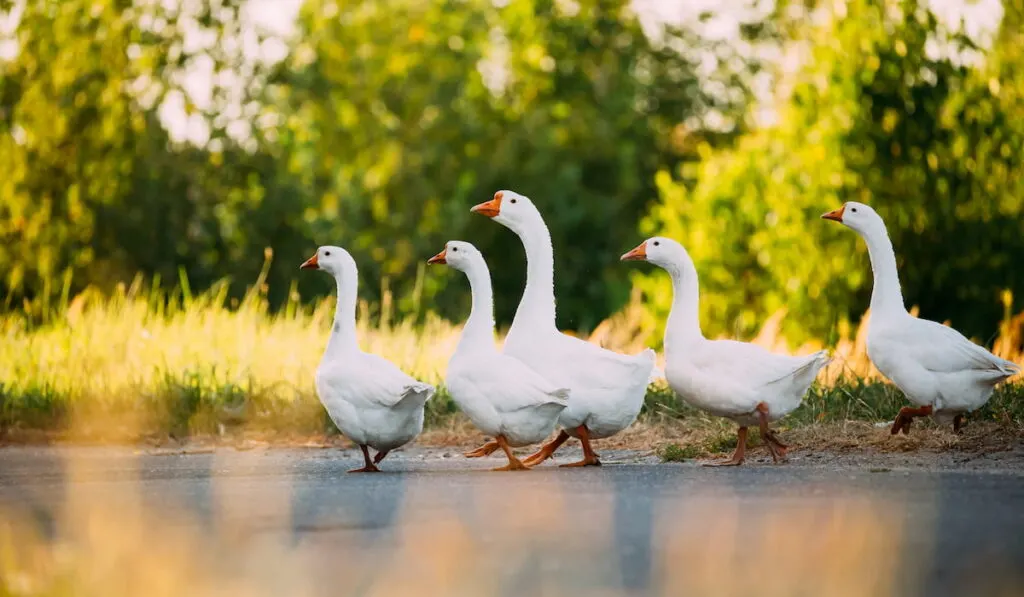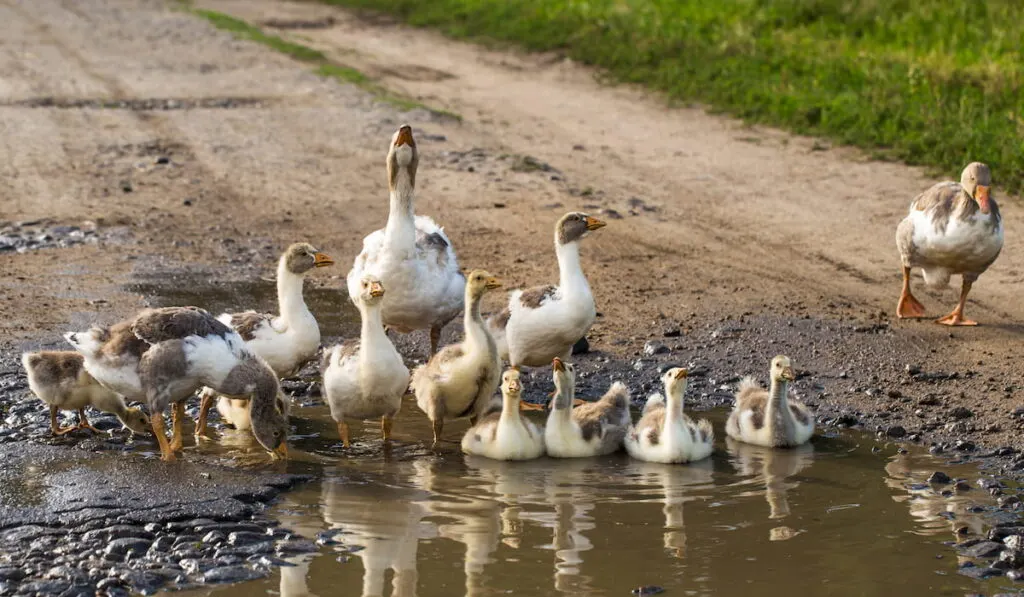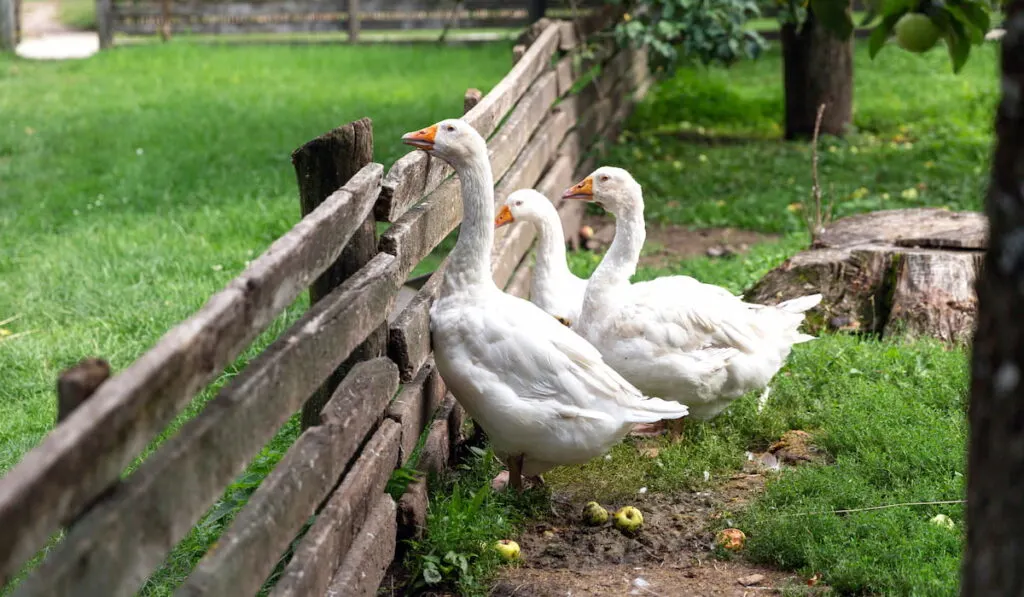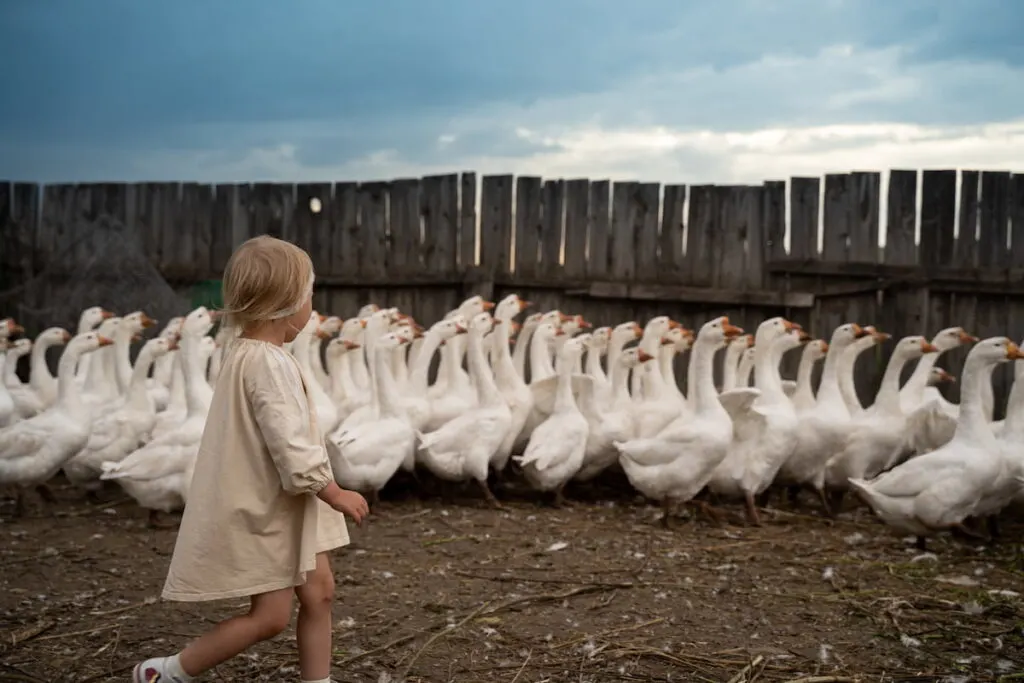Geese, the cattle of the poultry world, are at the top of my list for self-raised meat in smallholding spaces. They are incredibly hardy fowl, economical, and environmentally friendly lawnmowers, but they are not suitable for everyone.
Geese are generally hardy, low-maintenance, and easy to care for fowl. They thrive on various natural grasses and fresh water to drink and bathe in.
Provide your geese with a safe indoor living space to protect them from predators, and an outdoor area with fresh water, lots of grass, and shaded areas to keep them happy.
Geese take good care of themselves and require low maintenance and upkeep, but there are a few good-to-know tips on how to raise geese. Continue reading for the ultimate guide to raising geese.

Table of Contents
Purposes Of Geese?
Raising geese is quickly rising in popularity as many new farm owners or homesteaders take on geese as a hobby or means to profit.
Geese are purchased for many different purposes, such as:
Grass control: Geese are entirely vegetarian and love to graze on grass.
Meat: Goose meat is dark and rich, and often sold as a specialty.
Eggs: Goose eggs are enormous compared to chicken eggs. Goose eggs are great for baking, poaching, or scrambling.
Feathers or Down: Pillows, cushions, throws, and clothing are often made from goose down.
Profit: They are hardy, disease-resistant, and easy to care for, making them great for business. Due to goose eggs’ size, novelty, and rarity, they command a higher price than chicken eggs.
Lastly, selling goslings can give you a profitable return.
Breeding: You could specialize in rare breeds or opt for the most popular species.
To spruce up a property or pets: Geese can be affectionate, intelligent, loyal, and charming fowl pets.
How To Select A Goose Breed?
Once you’ve determined the reason for purchasing and raising geese, you need to select a breed matching your purpose.
Geese fall into three main categories depending on their size (light, medium, and heavy).
Light and medium geese are excellent for egg production, while heavy geese are excellent meat sources.
Here is a shortlist of light, medium, and heavy geese:
| Light Geese | Medium Geese | Heavy Geese |
| Pilgrim, Chinese Goose, Czech, Roman Goose, Sebastopol, Steinbacher, Saddleback | Brecon, Buff, Greyback, Pomeranian, West of England Goose | Embden, African Goose, American Buff, Toulouse |
How Does It Take To Raise Geese?
It can take two years for geese to reach full maturity; the exact length varies on the breed of goose.
Goslings have soft down when they hatch. They molt the down in exchange for juvenile plumage at 3 to 5 weeks old.
Parent geese care for their gosling until they are ten weeks old (the dad mostly babysits). Then, typically, young geese can stay with their parents and siblings for their first year.
How To Create A Home For Geese?
Similar to most animals, geese are happiest with tons of roaming space.
However, in addition to a safe, indoor area, geese also need a lot of freshwater access for drinking, cleaning, and swimming. Therefore, predator-proofing your indoor and outdoor spaces is a MUST!
Indoor Living Areas For Geese
A barn, a shed, and even a garage can make a suitable indoor living area for geese; be sure to follow specific guidelines.
There are many commonalities between living spaces appropriate for geese and chickens or other birds. However, remember that geese have unique needs that you should be sure to meet.
- The entrance to a goose’s indoor living area should preferably be at ground level.
- If the entrance is above ground level, offer a wide ramp on a gentle incline.
When creating living spaces, it is vital to ensure that your geese have enough space. The Global Federation of Animal Sanctuaries states that indoor shelters should provide a minimum of six square feet of open floor space per goose.
Predator-Proofing Your Indoor Living Space For Geese
Geese may be known for their guarding instincts; however, they are still vulnerable to predators, especially at night. So, geese require an indoor living space to protect them from predators. They should be closed in before dusk and only let out when the sun rises.
Tip: A helpful rule of thumb is to avoid openings bigger than the size of a quarter. Weasels can easily squeeze through small spaces and can kill a goose. So, we suggest that all doors are covered with a ½ inch galvanized hardware cloth.
Flooring
Keep in mind that heavy goose breeds need flooring with more traction than the smaller goose breeds.
Concrete, dirt, and wood are common flooring types. Concrete is the most sustainable as it provides good protection and won’t incur damage when exposed to water.
However, make sure the concrete is slightly textured to provide traction.
In addition to your flooring, geese need ample dry bedding to prevent hock and keel sores from laying on hard surfaces for prolonged periods.
Common bedding types to use:
- Straw
- Aspen wood shavings
- Pine wood shavings
Note: never use cedar wood shavings as it causes respiratory issues.
Accessories For Indoor Living Areas For Geese
When temperatures are overly hot outdoors, indoor areas need maintaining to comfortable, well-ventilated, and liveable temperatures.
Consider adding the following accessories:
- Industrial circulating fans
- Industrial exhaust fans
- Open windows
- A predator-proof screen door
- Water to swim in
On the contrary, during icy winters, geese need protection despite their hardiness in cold weather. Keep the ground covered with straw to protect their feet from frostbite and keep them inside their living area (ensure that it is draft-free).

Outdoor Living Areas For Geese
Most geese love to swim, forage, and explore in the sun. So, ensure you provide your geese with safe outdoor roaming space during the daytime.
The more versatile your outdoor space, the better! Enrich their outdoor living space by providing access to a swimming pond, marshland areas with tall grasses, shorter grassy areas for grazing, and shaded areas for mid-afternoon naps.
If you can’t provide a swimming pond, dig a small pond with a plastic liner, or use a water trough or a thick, hardy plastic pool as excellent alternatives. If you’re opting for the plastic pool option, ensure to provide a gently sloped ramp to provide a safe way to get in and out of the water.
A fully enclosed aviary will ensure that your geese have protection against predators. However, it’ll be best to use an 8-foot high fence because predators like foxes and coyotes jump over 5-foot fencing. For further precaution, bury a portion of the fence to prevent digging predators.
Roosting And Nesting Options For Geese
Geese generally sleep on the ground, but straw bales provide safe opportunities for geese to roost off the ground.
Laying female geese sometimes utilize man-made nooks, but most prefer to build their own nest (corners tend to be popular spots).
Strawbale structures make great nesting and roosting areas!
Poultry Fencing For Geese
Apart from housing, poultry fencing may be the only significant, costly investment you’ll need to make when housing geese.
Ideal fencing would be an 8-foot-high mesh fence with electric wires on the outside of the fence, and 12 inches of fencing buried to deter climbing and digging predators.
Food Requirements For Geese
Geese are incredibly easy to raise; the majority of their diet is grass.
A general rule of thumb would be to provide a pair of domestic geese with a quarter of an acre of grass.
However, the nutritional value of grass may vary throughout the year, so you need to provide them with wheat or layer pellets as additions to their diet.
In addition, geese require insoluble poultry grit (small hard rocks and pebbles) and sand to grind down and digest their food.
You can also add the following the improve the diet:
Grains: these can include oats, corn, and wheat.
Greens: Geese generally prefer clover, orchard grass, bluegrass, and bromegrass. These greens will provide vitamin A and calcium to your geese.
Niacin: Geese require a supplement containing niacin in their diet to prevent joint issues.
Vitamin A & Calcium: Be sure to monitor your residents’ eggshells; if their eggs are soft, they may require a supplement to increase their vitamin A and calcium levels.
Vitamin D: If you live in an area with long, dark days, provide vitamin D to prevent weak bones and eggshells.

Food Storage For Geese
Store all food, including unopened bags in dry, cool, dark places, tightly sealed metal containers, or thick plastic bins to prevent rats, raccoons, and other rodents from accessing the food.
Food Toxic To Geese
There are numerous foods and plants indigestible or toxic to geese. Do not feed the following foods to geese:
- Avocado (contains persin)
- White potato & green potato (contains solanine)
- Green tomato (contains solanine)
- Eggplant and pepper leaves (contains solanine)
- Onions (contains thiosulphate)
- Apple, pear, peach, apricot, cherry, plum seeds or pits (contains cyanide)
- Rhubarb (contains oxalic acid)
- Dried or raw beans and bean plants (contains phytohemagglutinin); however, fine when sprouted
- Raw nuts and peanuts (inhibit protein absorption)
- Chocolate- contains the toxin theobromine
- Coffee & tea
- Anything moldy or rotten
- Alcohol
- Processed foods
- All plants sprayed with pesticides or herbicides
Treats For Geese
Geese love an occasional treat, and treats can also serve as a motivator to move your geese to a specific area.
Some good treats include:
- Broccoli
- Cucumber
- Peas
- Corn
- Kale
- Pumpkin
- Sliced and CORED apple
- Watermelon
- Cantaloupe
- Berries
- Bananas

Brooding Geese
Brood goslings at 90°F for the first week, and then temperatures are lowered by 5 to 10 degrees weekly until you reach 70°F if you’re using a heat lamp.
After 5 to 6 weeks, your goslings typically no longer need heat. Therefore, move your goslings out to their adult pens and pasture after six weeks.
Gosling Feed Requirements
First, you will need to provide large amounts of fresh water for your goslings to drink. A regular chicken waterer is perfect for the brooder.
Feed your goslings as much fresh grass and weeds as they want with an added waterfowl starter (medicated or unmedicated is fine).
After six weeks, your goslings only require poultry feed as a supplement if they have daily access to good pasture.
Your goslings may require niacin supplements (brewer’s yeast or infant vitamins) to prevent leg problems.
How Much Do Geese Cost To Raise?
For a flock of free-range geese, feeding costs typically do not put a dent in an owner’s wallet. The annual feeding cost of an adult goose is approximately $22.94. And the feed cost to raise goslings to 12 weeks is about $12.68.
Geese Health Issues
Geese are typically very healthy fowl but can develop common ailments, including the following.
- Angel Wing: A deformity on one or both wings in which the last joint of the wing is twisted, with the wings pointing out laterally and unable to sit flush at the goose’s side. This deformity occurs from an unhealthy diet of rich protein and carbohydrates and a nutritional deficiency in vitamins and minerals.
- Bumblefoot: A staphylococcus bacterial infection knows as plantar pododermatitis occurs in a goose’s foot. The condition displays symptoms including excessive swelling, redness, and black or brown scabs on the bottom of the foot.
- Egg Bound: When an egg is stuck inside a female goose’s oviduct, she is said to be egg-bound. Being egg bound is a life-threatening condition caused by calcium deficiency, oviduct infection, and an extra-large egg.
- Eye Infection: Also known as “Sticky Eye.” A goose can get an eye infection from getting scratched by a fellow flock mate or getting debris caught in their eyes. Symptoms generally include redness, a closed or blinking eye, bubbles in the eye, or excessive tearing.
- Spraddle Legs: Caused by an issue occurring during incubation or hatching or housing geese on a slippery floor. Their leg muscles do not develop properly.

Caring And Grooming For Geese
Geese generally require less maintenance than many other domestic poultry birds. They do, however, have the following care and grooming requirements:
Geese Need Their Wings Clipped
Clip the wings of your newly purchased geese before releasing them. Note that geese are powerful birds, and precaution is needed while clipping their wings.
Believe it or not, this is a tough and challenging task that generally requires 2 to 3 persons.
When clipping their wings, gently hold their neck and body firmly and have another person gently unfold their wings and cut the wings shorter at the base of the wing. Be extra careful and do not overcut their wings.
Water For Bathing Geese
Geese need plenty of clean, fresh water for drinking and washing their heads. Therefore, ensure that their water containers are deep enough to submerge their entire head into the water.
Clean bathing water should be offered about three times a week for most of the year, and in the breeding season, offer clean bathing water daily.

Companionship For Geese
You can raise a single goose if you’d like, but note that they are much happier living in flocks. Some homesteaders own a single goose to keep guard of their chicken flock- they are excellent at sounding alert when danger is close.
If you choose to raise a single goose, be sure to give it plenty of attention.
Although geese prefer living flocks, larger flocks are best kept alone. They are very territorial and may kill your chickens or other fowl.
Fun fact: Most geese are monogamous; they tend to have one partner for their entire life.
Conclusion
Raising geese is fun, easy, and can even make a good buck, providing you do your homework first!
These fowl are hardy, low-maintenance, and budget-friendly.
We hope you’ve enjoyed reading the ultimate guide to raising geese.
